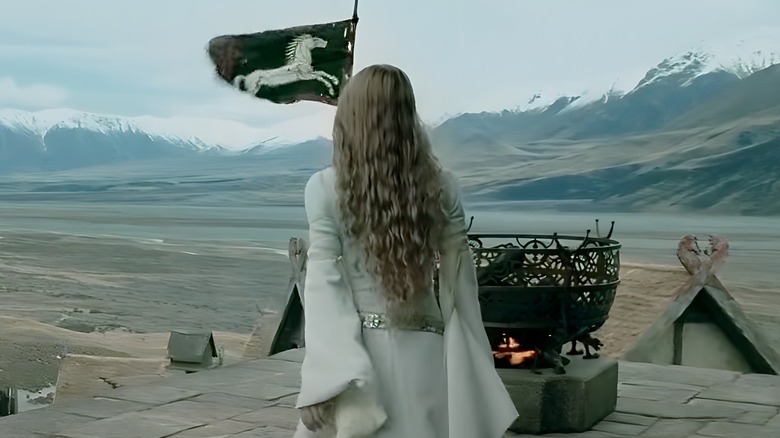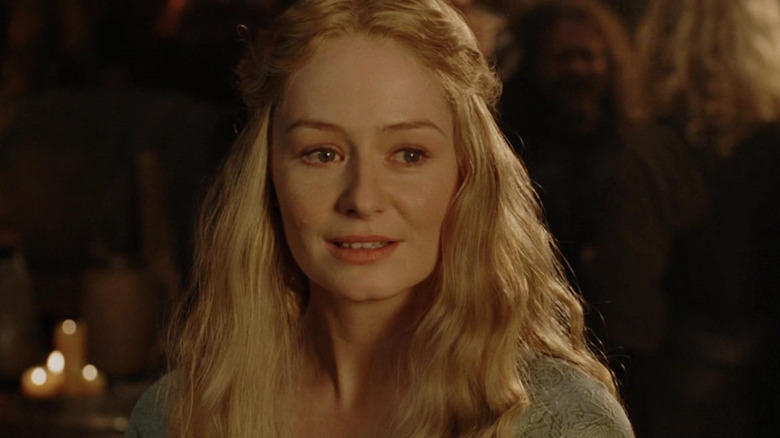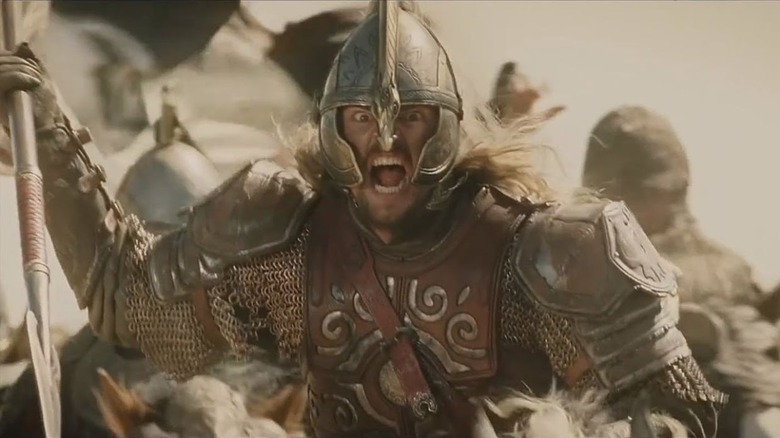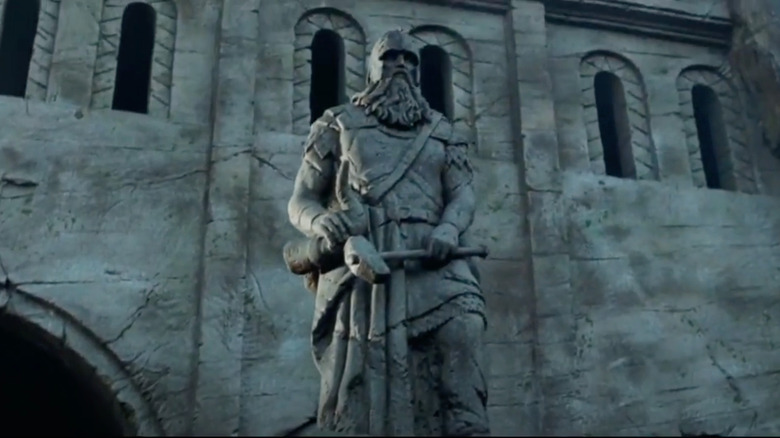The War Of The Rohirrim: Who Is Héra? The Protagonist Explained
Contains potential spoilers for "The Lord of the Rings: The War of the Rohirrim"
"The War of the Rohirrim" is a highly anticipated upcoming film that will mark the first time Tolkienian cinematic adaptations venture into the world of Japanese anime. The story is set roughly 250 years before the War of the Ring, and it will center on a conflict that ultimately leads to the King of Rohan, Helm Hammerhand (Brian Cox), fighting for his own life and that of his family and nation in the fortress that is eventually named after him.
However, recent news has clarified that the Helm character, while central to the story, won't be the movie's primary protagonist. This will be a much more obscure individual: Helm's daughter. Relaying information shared at a sneak peek of the film at the Annecy International Animation Film Festival in mid-June, /Film reported that Helm's daughter "here named Hèra, is the protagonist of 'The War of the Rohirrim.'" The publication adds shortly after this, "Centering the film around Hèra is smart, because of how little we know of her. As we hear in the opening narration, 'Do not look for her in old songs, for there are none.'"
Why do we know so little about Héra?
If you're wondering why we don't know much about Héra and why she isn't mentioned in the old songs, there's a simple explanation: J. R. R. Tolkien never wrote about her. In fact, he only mentions Helm's daughter once in his writings, and not even by name. That's right: Héra is a made-up moniker for the film. To explain, let's back up and look at the books.
Much like the source material for Amazon Prime's "The Rings of Power," Warner Bros. Discover's Rohan anime finds its inspiration in the appendices of "The Return of the King." This extensive collection of final notes comes after "The Lord of the Rings" story ends. Tolkien used them as an information dump for a reading audience that, at the time, didn't have access to his posthumously published books, like "The Silmarillion" and "Unfinished Tales."
In the appendices, we get several pages that briefly recount the disastrous reign of Helm Hammerhand. It details a dramatic story rife with emotional outbursts, unrestrained violence, war, famine, and of course, a close connection between Gondor and Rohan.
Without giving too much away, the Dunlendings are Rohan's primary antagonists at this time (they are the wild-looking men who swear a blood-oath to Saruman in "The Two Towers" film). One of their chieftains with a potential blood connection to the throne of Rohan, named Freca, comes to one of King Helm's councils, and the text adds, "he asked the hand of Helm's daughter for his son Wulf." Helm rejects the offer with scorn — it actually is the catalyst for all of the drama that follows — but for our purposes here, well, that's it. That's the only time Helm's daughter is mentioned. His sons, Haleth and Háma are named. But their sister remains in the dark.
Why choose Héra as the protagonist?
Opting for the unnamed and underdeveloped character of Helm's daughter as a primary perspective for the movie is clever. It gives the team plenty of creative liberties to develop a princess that modern audiences can relate to as they attempt to keep up with the classic and ancient storytelling model that J. R. R. Tolkien uses throughout his histories. But there is another, more practical reason for why the production team has opted for Helm's daughter as the focal point of their story: she survives it — or at least, the sparse text never says she doesn't do so.
When asked at the Annecy presentation why they chose to go with the story's most forgettable character as their protagonist, "The Lord of the Rings" movie trilogy co-writer Philippa Boyens succinctly summed up the decision in three words, "Everyone else dies!" While this is a little bit of an oversimplification, it does touch on a major aspect of the Helm Hammerhand narrative: it's a tragedy through and through. The good guys are riddled with ethical shortcomings, and the villains aren't one-dimensional Orcs — they're fellow Humans. The two groups come to blows over a Hatfield and McCoy-level feud that leaves both utterly devastated (and inadvertently opens up the doors for a certain White Wizard to settle down at Isengard when the dust settles).
If you look hard enough, there are certainly other options for a protagonist. However, choosing to work with a key canon character that is so underdeveloped she doesn't even have a name is a great way to split the difference. By creating "Héra," the team behind the "The War of the Rohirrim" is technically sticking to canon while buying themselves the greatest space to exercise creative liberties as they tell the story.
So, who is Héra, then?
Okay, so if Helm's unnamed daughter is little more than a passing mention in the source material, who is she going to be in the animated feature film? /Film paraphrased director Kenji Kamiyama's description of Héra as "tomboy-ish, a young woman who is wild and vulnerable, with a character arc that sees her grow in a time of war — because you can't really have a Middle-earth story without war."
/Film also noted that the creatives cited the real-life historical figure Æthelflæd as a source of inspiration. For those who may not know, Æthelflæd is an incredible character in English history. She is the oldest child of Alfred the Great, and, in the 10th century, she and her brother, Edward the Elder, worked together to rid their homeland of Viking invaders. This is fascinatingly close to the situation toward the end of "The War of the Rohirrim" storyline.
Earlier in that story, the Dunlendings overrun Rohan and drive its inhabitants into the mountains for shelter. Some escape to Helm's Deep (which isn't called that yet), including their king, Helm Hammerhand. In J. R. R. Tolkien's writings, both of Helm's sons die in the film's titular war. Elder Prince Haleth falls defending the Golden Hall, and younger Prince Háma perishes in the siege of future Helm's Deep. Helm also meets his end in that conflict. Eventually, Helm's nephew, Fréaláf, leads a desperate counterattack and drives the Dunlendings out of the land, Æthelflæd-style.
Throughout all of this, the fate of the deceased King's daughter is unknown — at least for now. As the opening narration for "The War of the Rohirrim" has already made clear about Héra's story, "Do not look for her in old songs, for there are none."



